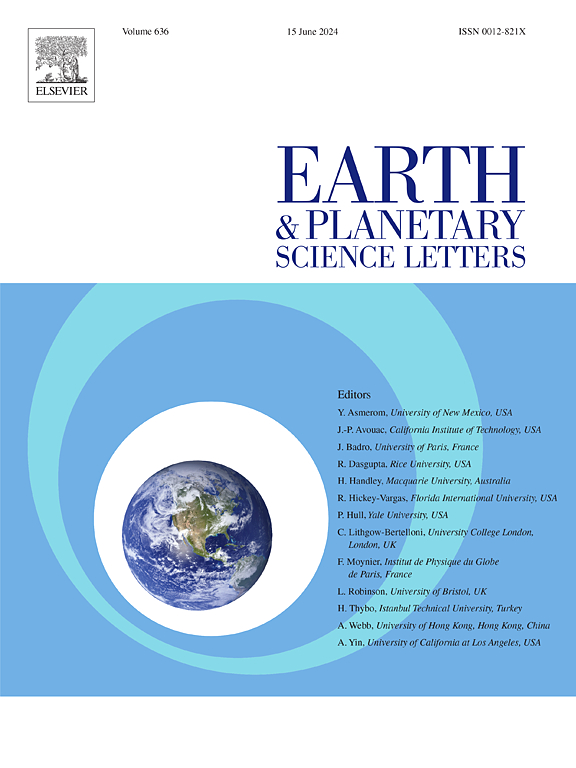Lithium isotopes track changes in continental weathering regimes across the end-Permian mass extinction in Southwest China
IF 4.8
1区 地球科学
Q1 GEOCHEMISTRY & GEOPHYSICS
引用次数: 0
Abstract
It has been assumed there was a massive amount of volcanic CO2 injection into the Permian-Triassic atmosphere and ocean systems, leading to rapid climatic warming and expansion of marine anoxia. However, it remains intriguing how Earth recovered from such a CO2-driven hyperthermal condition. One potential mechanism involves the negative feedback between continental silicate weathering and atmospheric CO2, which could have helped maintain habitability across the end-Permian mass extinction (EPME) interval. This process can be examined using lithium isotopes (δ7Li), which reflect the balance of physical erosion and chemical weathering, and chemical weathering indices such as the Chemical Index of Alteration (CIA), which indicates the chemical alteration of parent materials during weathering. In this study, we analyze siliciclastic sedimentary rocks from the Lopingian to Lower Triassic depositional sequences in the HK-1 drill core at the Lengqinggou section, a terrestrial coastal depositional environment in Southwest China, to reconstruct changes in continental chemical weathering intensity across the EPME. We observed a significant ∼4 ‰ positive shift in δ7Li, accompanied by a marked decrease in Li content from 26 ppm to 6 ppm. Our corrected CIA data (CIAcorr) also exhibits a considerable decrease from 94 to 59 across the EPME. The new δ7Li and CIAcorr data from the terrestrial section indicate a decrease in overall chemical weathering intensity in Southwest China, alongside an increase in physical erosion rates, suggesting a shift from a transport-limited to a kinetically limited weathering regime across the EPME. These changes in the continental weathering regime appear to be linked to active volcanic activity near the South China Block, which led to massive deforestation and the collapse of soil systems. Dramatic reductions in chemical weathering intensity may result in inefficient atmospheric CO2 consumption through silicate weathering if other climatic and tectonic conditions remain constant, potentially contribute to maintaining high global surface temperatures and prolonged marine anoxia into the Early Triassic.
锂同位素追踪中国西南地区二叠纪末大灭绝期间大陆风化机制的变化
据推测,在二叠纪-三叠纪大气和海洋系统中注入了大量的火山二氧化碳,导致气候迅速变暖,海洋缺氧现象扩大。然而,地球是如何从这种由二氧化碳驱动的高热状态中恢复过来的,仍然令人好奇。一种潜在的机制涉及大陆硅酸盐风化与大气二氧化碳之间的负反馈,这可能有助于维持整个二叠纪末大灭绝(EPME)时期的宜居性。锂同位素(δ7Li)可反映物理侵蚀和化学风化的平衡,而化学风化指数(如化学蚀变指数(CIA))则表示母质在风化过程中发生的化学蚀变。在本研究中,我们分析了中国西南陆相海岸沉积环境冷清沟地段HK-1钻芯中洛坪系至下三叠统沉积序列的硅质沉积岩,重建了整个EPME大陆化学风化强度的变化。我们观察到δ7Li发生了明显的∼4 ‰正向移动,同时Li含量从26 ppm显著下降到6 ppm。我们的校正 CIA 数据(CIAcorr)也显示出整个 EPME 从 94 下降到 59。来自陆地剖面的新δ7Li和CIAcorr数据表明,中国西南地区的总体化学风化强度下降,同时物理侵蚀速率上升,这表明整个EPME的风化机制从迁移受限转变为动力学受限。大陆风化机制的这些变化似乎与华南地块附近活跃的火山活动有关,这些活动导致了大规模的森林砍伐和土壤系统的崩溃。如果其他气候和构造条件保持不变,化学风化强度的急剧下降可能会导致硅酸盐风化对大气中二氧化碳的低效消耗,从而有可能导致全球地表温度居高不下和海洋缺氧现象持续到早三叠世。
本文章由计算机程序翻译,如有差异,请以英文原文为准。
求助全文
约1分钟内获得全文
求助全文
来源期刊

Earth and Planetary Science Letters
地学-地球化学与地球物理
CiteScore
10.30
自引率
5.70%
发文量
475
审稿时长
2.8 months
期刊介绍:
Earth and Planetary Science Letters (EPSL) is a leading journal for researchers across the entire Earth and planetary sciences community. It publishes concise, exciting, high-impact articles ("Letters") of broad interest. Its focus is on physical and chemical processes, the evolution and general properties of the Earth and planets - from their deep interiors to their atmospheres. EPSL also includes a Frontiers section, featuring invited high-profile synthesis articles by leading experts on timely topics to bring cutting-edge research to the wider community.
 求助内容:
求助内容: 应助结果提醒方式:
应助结果提醒方式:


